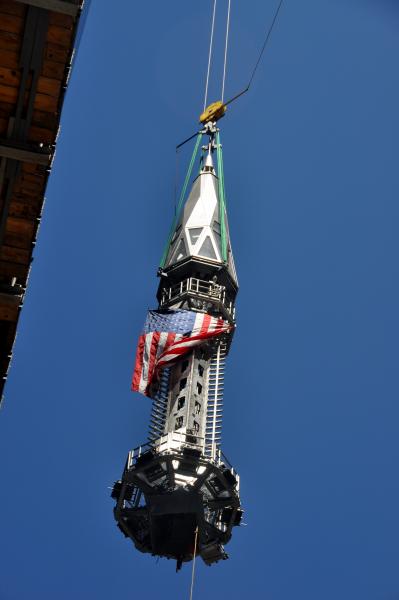New York's World Trade Center has new spire, but no broadcasters on top
When the gleaming spire was placed atop One World Trade Center (1WTC) building last week, it was the captivating culmination of years of hard work to rebuild the skyscraper (and the nation’s psyche) after the terrible events of Sept.11, 2001. Symbolically, the 1WTC building — erected on the site where the Twin Towers used to stand — now measures 1776ft tall and stands as the tallest building in the Western Hemisphere.
The only thing it’s missing is a broadcast antenna and television (and radio) transmission equipment, as agreements to move the region’s local broadcasters from their nearby Empire State Building and 4 Times Square locations have not been reached. Broadcasters we contacted declined to comment publicly on the on-going negotiations, but there is interest once current leases with Empire State and 4 Times Square, some set to expire in 2015, run out.
Installation of the 800-ton, 408-foot spire actually began in December, after 18 pieces were shipped by barge from Canada and New Jersey. The impressive building, replacing the former broadcast home of most of the local broadcasters (except for WCBS-TV) is scheduled to open for business in 2014. Since 9/11, stations have moved to Empire State as well as 4 Times Square, in the heart of the city. An agreement to move local stations’ equipment may be a bit farther off, as current lease deals and reluctance among some stations to move, will delay any activity in this regard.

The new tower's LED-lit spire was fabricated in a joint venture between the ADF Group, an engineering firm in Terrebonne, Quebec, Canada, and the New York-based DCM Erectors, a steel contractor. Most of the spire was assembled in South Plainfield, NJ, at a sister company called MRP LLC.
John Lyons, assistant vice president and director of broadcast communications for The Durst Organization, the real estate company that manages and leases space at One World Trade, said weather conditions have delayed the final stages, as the spire is being lifted into place by a massive crane. The spires is literally sitting on the roof top right now, but will be completely secured within a matter of days.
“We are in active conversations with several of the broadcasters right now,” Lyons said. “The major holdup right now is the looming repacking of channels [which will occur once the broadcast spectrum auctions are completed in June of 2014]. Basically, we’re all waiting to see what happens with the auction. For us, it’s holding up which antenna we choose what I buy and other equipment, because right now we don’t know what frequency they will be operating at.”
Lyons said his assumption, and that of most people, is that there will not be a lot of relocation of New York area stations and that they will maintain their current channel assignments.
The professional video industry's #1 source for news, trends and product and tech information. Sign up below.
“While we wait, we are having discussions with stations and finding out what their requirements are,” Lyons said.
At this point there has been no construction on transmission rooms or other accommodations at the top of one World Trade Center, but Lyons said there would be. Space has been allocated and several 2MW backup generators have already been installed.
”Everything they need for a fully functioning broadcast facility will be supplied once agreements are reached,” Lyons said.
There’s much to be lost for the Empire State and its management company W&H Properties should stations move to 1WTC. Management has reported in public documents that lease payments from 16 TV station and 19 radio stations now operating there generated revenue of $16.1 million in 2010 and $11.8 million in the first three quarters of 2011. According to an IPO prospectus, the average remaining years of the broadcast leases was 7.5 years. Some end as soon as 2015.
However, one concern for broadcasters that are considering a move is the building’s height. Since 1WTC is now higher than the Empire State Building (at 1,454 feet), stations are cautious about not losing local DMA viewers by “overshooting” them. Extensive field-testing needs to be done, as the 1776 ft height of 1WTC could reduce the effective radiating power of the UHF antenna. In addition, the FCC has a rule that power levels must be lowered as you go higher up in elevation so as not to interfere with airline communications. But none of this can be tested without an antenna on top of 1WTC.
“Understandably stations are concerned that what we put up there will retain the audience they currently have in the near-field urban market of New York City,” Lyons said. “And we don't want to be building something that does not meet the broadcasters’ requirements. So, we’re listening to the stations and looking to come up the best facility we can.”
Lastly, the issue of installing an antenna after the spire has been put in place could be an expensive proposition for The Durst Organization. Richard Gilbert, safety and operations manager, DCM Erectors (which built the spire), said retrofitting that antenna is now going to be tricky and much more expensive than it would have been otherwise.
“The spire was designed to support a broadcast antenna,” Gilbert said. “All of the [fiber and electrical] connections are there, but there’s no antenna at this point. I’ll tell you, it’s going to be a lot more expensive to install that antenna at a later date.”
